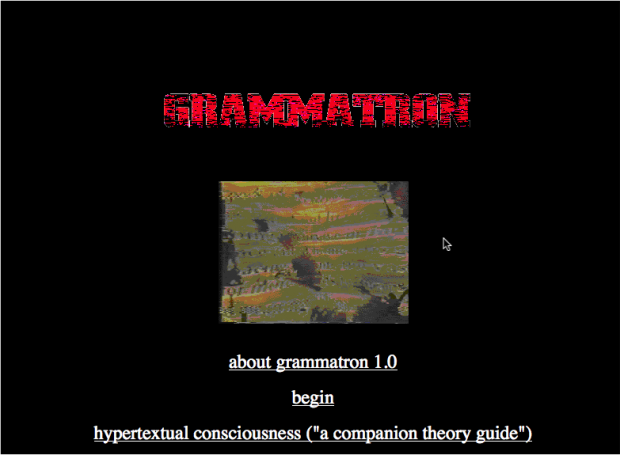GRAMMATRON
Inspired by Derrida's Of Grammatology, Mark Amerika experiments in GRAMMATRON with narrative form in a networked environment. Amerika retells the Jewish Golem myth by adapting it into the culture of programmable media and remixing several genres of text into the story's hybridized style, including metafiction, hypertext, cyberpunk, and conceptual works affiliated with the Art+Language group.
Narrated from various authorial perspectives, the story introduces readers to Abe Golam, a pioneering Net artist who creates Grammatron, a writing machine. Endowed not with the Word (as in the original myth) but with forbidden data—a specially coded Nanoscript—the creature becomes a digital being that "contains all of the combinatory potential of all the writings." The Grammatron is the personification of the Golem, which is also a personification of Amerika the artist. While the Golem and its environment have been depicted in any number of literary adaptations and works, in GRAMMATRON, Mark Amerika creates a seemingly infinite, recombinant (text-)space in the electrosphere.
Throughout the story, Abe Golam searches for his "second-half," a programmer named Cynthia Kitchen whose playful codes of interactivity lead both Golam and readers through a multi-linear textscape (the Grammatron writing machine) where they search for "the missing link" that will enable them to port to another dimension of "digital being" the story refers to as Genesis Rising.
The project consists of over 1100 (partly randomized) text elements and thousands of links. It comes with animated and still life images, an eerie background soundtrack, and audio-files that sometimes provide a spoken meta-commentary on the work itself. The work consists of different text-layers the user is free to choose from, including a theoretical hypertextual essay titled "Hypertextual Consciousness," the animated text "Interfacing," and the main hypertext "Abe Golam."
GRAMMATRON (1997) was initially received as one of the first major works of Net art and was selected for the 2000 Whitney Biennial of American Art. It was the first work in Amerika's Net art trilogy and was followed by PHON:E:ME (1999) and FILMTEXT 2.0 (2001-2002).
(Source: Electronic Literature Directory entry by Patricia Tomaszek)




